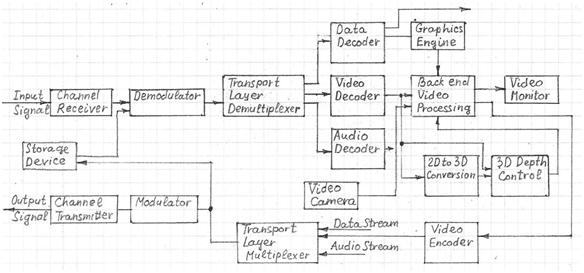Video processing is an essential part of signal processing to change the characteristics of the video signal, improve or degrade video quality, convert the video signal into a signal that matches the communication channel, storage media, etc. and vice versa.

Video processing from channel, storage to the monitor.
Compressed, encoded, and modulated video signal is received from the communication channel or it is retrieved from the storage device. The signal is extracted and separated from other channel or storage signals, amplified, and shifted in frequency domain (if necessary). Then it is demodulated and converted into digital stream. The digital stream may contain one or more compressed video channels, audio channels as well as data channels.
The digital stream has to be demultiplexed to extract the particular video bitstream, corresponding audio stream(s) and corresponding side data information that could be displayed on the monitor together with video. Digital video is decompressed in the video decoder and before displaying on the monitor is processed in Backend Video Processing. Side data through the Graphic Engine may be inserted into video signal side graphic information.
Backend Video Processing includes noise reduction, deinterlacing, resolution scaling, enhancement, frame rate conversion, color space conversion, brightness/contrast/gamma adjustment. Sometimes a 2-D video signal may be converted to 3-D video signal, or a video signal may be 3-D by itself. In this case 3-D depth control block is used. From backend processing, video is displayed on the monitor.
Video processing from video source to the channel, storage.
In the opposite direction, video processing starts from a video source. In most cases, the source is a video camera. The signal may be pre-processed by devices that are similar to backend processing, compressed by a video encoder, and multiplexed with audio or other streams. At output, the video can be stored in the storage media or modulated and transmitted to the communication channel.